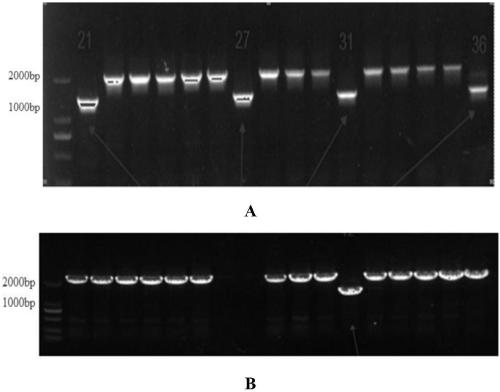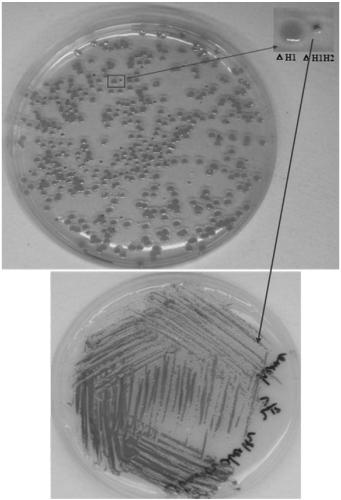Protoporphyrin PPIX-high-yielding shewanella genetic engineering bacterium and construction method thereof
A technology of Shewanella and construction method, applied in the field of genetic engineering, can solve the problems of high price, long production cycle and high extraction cost, and achieve the effect of high price and high quality
- Summary
- Abstract
- Description
- Claims
- Application Information
AI Technical Summary
Problems solved by technology
Method used
Image
Examples
Embodiment 1
[0030] Example 1: Construction of Gene Knockout Suicide Plasmid
[0031] The upstream and downstream parts of the hemH1 and hemH2 genes were connected and introduced into the multiple cloning site of the recombination-integrated suicide plasmid PDS3.0 to obtain the suicide knockout plasmid p△hemH1 containing the hemH1 gene and the suicide knockout plasmid containing the hemH2 gene, respectively. Plasmid pΔhemH2 was removed. The specific operation is as follows:
[0032] According to the whole genome sequence (GCA_000146165.2) of wild-type Shewanella (S.oneidensis) MR-1 in the GenBank database, primers for knocking out hemH1 were designed respectively. The primer sequences are as follows:
[0033] hemH1-sacI-3o:GTgagctcGATGGCGGCAAACGGTATTA (with SacI restriction site)
[0034] hemH1-sacI-3i:agagacgacctaagccagtcGACGACCCGAGGATCACTTA
[0035] hemH1-sacI-5o:gactggcttaggtcgtctctCCAAGGCGTGAAAAGTGTCG
[0036] hemH1-sacI-5i:CAgagctcTCGTCGGCCAAAATAGAATA (with SacI restriction site) ...
Embodiment 2
[0048] Example 2: Construction of double gene knockout engineering strain MR-1ΔhemH1hemH2
[0049] Shewanella onedensis MR-1 was originally isolated from the anaerobic sediments of Oneida Lake in New York State, USA (Bacterial manganese reduction and growth with manganese oxide as the sole electron-acceptor. Science. 1988; 240(4857):1319–21.), is a Gram-negative bacterium belonging to a subgroup of the γ-proteobacteria, with facultative anaerobic characteristics, and the optimum growth temperature is around 30°C. As a model strain of Shewanella, it can be obtained in many laboratories, and can also be purchased from the BioVector plasmid vector strain cell gene collection center.
[0050] The principle and flow diagram of hemH1 and hemH2 gene knockout are as follows figure 2 As shown, the specific operation method is as follows:
[0051] First, the constructed gene knockout suicide plasmid p△hemH1 was transferred into the auxotrophic strain E.coliWM3064. The suicide plasmid...
Embodiment 3
[0055] Example 3: Chemical analysis of the red substance produced by engineering strain MR-1ΔhemH1hemH2
[0056]We qualitatively and quantitatively analyzed the red substance produced by the double gene knockout strain MR-1ΔhemH1hemH2 by ultraviolet spectrophotometry and mass spectrometry respectively. ,13,17-tetramethyl-21II,23II-porphine 2,18dipropanoieacid) standard sample and the red substance produced by double gene knockout engineering strain MR-1ΔhemH1hemH2 were dissolved in 90% acetone solution and 10% 0.1mol / L NH 4 In OH, use a UV spectrophotometer (BiowaveII, WPA), measure the absorption peaks of the standard sample and our sample to be tested with a quartz cuvette in the wavelength range of every 10nm, so as to measure the absorption peak curve, and read its The maximum absorption peak, and found that the maximum absorption peak appears at the same time around 405nm (such as Figure 5 ). And the result of mass spectrometry analysis also shows that the mass spectro...
PUM
 Login to View More
Login to View More Abstract
Description
Claims
Application Information
 Login to View More
Login to View More - R&D
- Intellectual Property
- Life Sciences
- Materials
- Tech Scout
- Unparalleled Data Quality
- Higher Quality Content
- 60% Fewer Hallucinations
Browse by: Latest US Patents, China's latest patents, Technical Efficacy Thesaurus, Application Domain, Technology Topic, Popular Technical Reports.
© 2025 PatSnap. All rights reserved.Legal|Privacy policy|Modern Slavery Act Transparency Statement|Sitemap|About US| Contact US: help@patsnap.com



